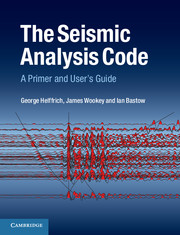Book contents
- Frontmatter
- Contents
- Preface
- Acknowledgements
- 1 Introduction
- 2 The SAC data format
- 3 The SAC processing philosophy
- 4 Basic SAC commands
- 5 SAC macros
- 6 Accessing SAC functionality and data from external programs
- 7 Graphical data annotation
- 8 Array data handling
- 9 Spectral estimation in SAC
- 10 Three-dimensional data in SAC
- 11 Implementation of common processing methodologies using SAC
- Appendix A Alphabetical list of SAC commands
- Appendix B Keyword in context for SAC command descriptions
- References
- Index
- Plate Section
10 - Three-dimensional data in SAC
Published online by Cambridge University Press: 05 October 2013
- Frontmatter
- Contents
- Preface
- Acknowledgements
- 1 Introduction
- 2 The SAC data format
- 3 The SAC processing philosophy
- 4 Basic SAC commands
- 5 SAC macros
- 6 Accessing SAC functionality and data from external programs
- 7 Graphical data annotation
- 8 Array data handling
- 9 Spectral estimation in SAC
- 10 Three-dimensional data in SAC
- 11 Implementation of common processing methodologies using SAC
- Appendix A Alphabetical list of SAC commands
- Appendix B Keyword in context for SAC command descriptions
- References
- Index
- Plate Section
Summary
THE CONCEPT OF 3D DATA
SAC has facilities for handling a basic type of three-dimensional (3D) data, which are function values evaluated on a regular grid of (X,Y) positions. This type of data can be viewed as evenly sampled in space and fits naturally into SAC file types. The file consists of the string of samples at each grid point, and file header information that flags it as 3D gives the X and Y dimensions of the grid. SAC calls data of this type XYZ.
The simplest visualization of 3D data is map elevation data. Imagine a section of land whose elevation is specified on a grid every 100 m eastwards and 100 m northwards. Over a plot of land 1 km by 1 km, the elevation could be described by a string of 121 values, the first 11 values along the westernmost traverse and the final 11 along the easternmost traverse.
Another type of data that can be represented in 3D is a spectrum as a function of time. If equal lengths of time are cut from a seismogram, the number of points in their FFTs will be the same. If the interval between spectral samples is constant, these values will also form agrid.
A final type of data inherently 3D is a misfit function evaluated over a two-dimensional (2D) grid of points. The misfit minimum within the sampled parameter space yields the optimum combination of parameters that best fit some observations, and the shape of the minimum provides a measure of the joint uncertainty of the parameter estimates.
- Type
- Chapter
- Information
- The Seismic Analysis CodeA Primer and User's Guide, pp. 115 - 122Publisher: Cambridge University PressPrint publication year: 2013

